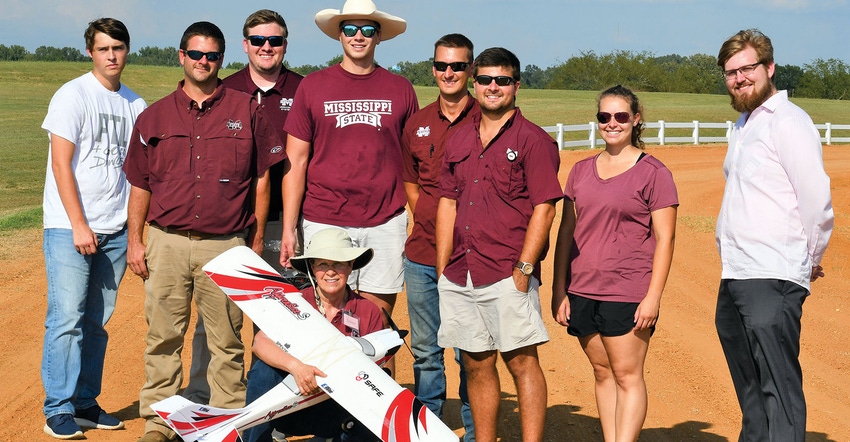
At the inaugural Unmanned Flight Experience at the Mississippi State University Horse Park, Amelia Fox, assistant clinical professor in the Department of Plant and Soil Sciences at MSU, introduced a developing technology using drones in agriculture.
Dennis Lott of UAS Solutions LLC (Clinton, Miss.) also volunteered time to give all MSU students in attendance a chance to experience unmanned flight technologies.
Fox is a co-copyright holder with Jac Varco and three undergraduate students at MSU who are working on a project using drone imagery to calculate variable rate prescriptions which show a $15/acre savings to farmers in the first year’s trials.
Vari-Rite technology
“We have at least two more years of testing ahead on this technology,” said Fox. “The program is called Vari-Rite, and it is a technology for assessing early crop nitrogen status by unmanned aircraft. We process the imagery from the drone, and within just minutes after it’s processed, we can create a variable rate prescription to reduce the amount of nitrogen used on a crop by knowing just the right amount the plants need. We use less chemicals, and the plants respond favorably with increased yields. Cotton responds particularly well to just the right amount of nitrogen.”
She emphasized how too much nitrogen on cotton can make it drop bolls early.
“We’re testing for three or four years in farm fields. So far, we have an Arkansas site, and we’ll be moving to a Mississippi site in summer 2020. We’ve been mainly in cotton, but now we’re going to test it out on corn,” Fox said.
Recent collaborators in Louisiana have also signed aboard to test Vari-Rite.
“It’s still in-process since it’s very novel technology,” she said.
Drones in precision agriculture
Fox said noted several ties to commercial agriculture with this program as well as using drones in general in agriculture.
“We are trying to help farmers assess their crops and make decisions,” she said. “Drones can be used to assess crop damage after a storm, help look for insect predation, or to estimate bio-mass which is a good proxy for yield.”
A few practices that drones can help farmers analyze when looking at a crop are yield estimations, nitrogen status, insect predation, drought or flood conditions, as well as harvest date estimation. However, drones may not be a good fit for farmers who aren’t technology savvy.
“It isn’t easy stuff,” she said. “It looks really simple, but it takes practice and guidance to become a good drone pilot.”
Drone technology hasn’t been used long in agriculture. Remote piloted drones have been in existence since the 1920s. According to Fox, a group of World War I veterans started the Academy of Model Aeronautics, which helped to launch drone applications. In the last 40 years, four-bladed and eight-bladed rotocopters came into existence. Individuals started flying them above crops and realized all the ways they could be useful in fields like agriculture.
Future of technology in ag
“We’re still in the infancy of this technology, but there is nowhere to go but up from here on out,” Fox said. “We think the copter styles are going to go out of fashion eventually, and fixed wing planes are going to become more fashionable because these can fly for hours while a rotocopter is limited by the battery size, usually 11 to 20 minutes.
“Dennis Lott has built a commercial-class fixed-wing sensing aircraft that flies over 1 hour using the same battery power as the copter style aircraft which runs for 10 minutes.
“This is great technology for precision ag because we want to put the right treatment in the right place at the right time at the right rate. The best way to do that is by using computer-based technology. We’re hoping more farmers are able to apply this technology in the future.”
Fox credits the support of the College of Agriculture and Life Sciences administration, George Hopper, Scott Willard, Wes Burger, and Darrin Dodds, the Plant and Soil Sciences chair, for providing the support of this on-going research, which all began in 2002, and continues today, under the guidance of Jac Varco, soil scientist and Triplett Endowed Chair in Plant and Soil Sciences.
To support the unmanned flight program or sponsor a training aircraft, there is an MSU Precision Agriculture Flight Fund in the MSU Foundation open for donations.
About the Author(s)
You May Also Like




